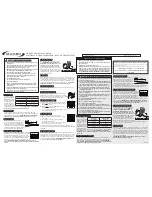
AIR SUPPLY AND CONNECTION
Do not use oxygen, combustible gases, or bottled gases as a power source for this tool as
tool may explode, possibly causing injury.
Do not use supply sources which can potentially exceed 80 P.S.I.G. (5.6 kg/cm
2
) as tool may
burst, possibly causing injury.
The connector on the tool must not hold pressure when air supply is disconnected. If a
wrong fitting is used, the tool can remain charged with air after disconnecting and thus will be
able to drive a staple even after the air line is disconnected possibly causing injury.
Clean, dry air as provided by the proper filter-regulator-lubricator is mandatory for satisfactory operation of the
tool. For proper functioning and lubrication, install this trio unit within 15 feet (4.8 meters) of the tool. Check
periodically for cleanliness and oil usage. Use only Mobil Velocite #10 or equivalent oil. DO NOT use a
detergent oil.
OPERATING PRESSURE
40 to 60 p.s.i.g. (2.8 to 4.2 kg/cm2). Select the operating pressure within this range for best fastener
performance.
DO NOT EXCEED THIS RECOMMENDED OPERATING PRESSURE
.
All hoses, pipes and pipe fittings must have a 3/8” (9.5 mm) minimum inside diameter. Hose fittings must
have a 9/32” (7.1mm) minimum inside diameter.
AIR CONSUMPTION
Air requirements will vary with operating speed and the type of material to be fastened. Do not use more air
pressure than required for the job. Air pressure in excess of the amount required to provide adequate
fastening wastes compressed air and may result in damage to equipment.
After all air connections are made, check for leaks.
CHOICE OF STAPLE SIZE
When letter “A” on D16112 clamp is in upper left hand corner refer to below listed chart as a guide for
establishing proper staple leg length and approximate clincher depth setting. NOTE: When D16112 clamp is
rotated 180º and letter “B” appears in the upper left hand corner the range of clincher depth settings is
lowered 1/32” (.79mm).
EYE PROTECTION WHICH CONFORMS TO ANSI SPECIFICATIONS AND PROVIDES
PROTECTION AGAINST FLYING PARTICLES BOTH FROM THE FRONT AND SIDE SHOULD
ALWAYS BE WORN BY THE OPERATOR AND OTHERS IN THE WORK AREA WHEN LOADING,
OPERATING OR SERVICING THIS TOOL. EYE PROTECTION IS REQUIRED TO GUARD AGAINST
FLYING FASTENERS AND DEBRIS, WHICH COULD CAUSE SEVERE EYE INJURY.
THE EMPLOYER AND/OR USER MUST ENSURE THAT PROPER EYE PROTECTION IS WORN.
EYE PROTECTION EQUIPMENT MUST CONFORM TO THE REQUIREMENTS OF THE AMERICAN
NATIONAL STANDARDS INSTITUTE, ANSI Z87.1 AND PROVIDE BOTH FRONTAL AND SIDE
PROTECTION. NOTE: NON-SIDE SHIELDED SPECTACLES AND FACE SHIELDS ALONE DO NOT
PROVIDE ADEQUATE PROTECTION.
CAUTION: ADDITIONAL SAFETY PROTECTION WILL BE REQUIRED IN SOME ENVIRONMENTS.
FOR EXAMPLE, THE WORKING AREA MAY INCLUDE EXPOSURE TO NOISE LEVEL WHICH CAN
LEAD TO HEARING DAMAGE. THE EMPLOYER AND USER MUST ENSURE THAT ANY
NECESSARY HEARING PROTECTION IS PROVIDED AND USED BY THE OPERATOR AND
OTHERS IN THE WORK AREA. SOME ENVIRONMENTS WILL REQUIRE THE USE OF HEAD
PROTECTION EQUIPMENT. WHEN REQUIRED, THE EMPLOYER AND USER MUST ENSURE
THAT HEAD PROTECTION CONFORMING TO ANSI Z89. IS USED.
TO LOAD
When loading tool: 1.) Never place a hand or any part of body in fastener discharge area of tool;
2.) Never point tool at anyone;
3.) Do not pull the trigger or depress the trip as accidental
actuation may occur, possibly causing injury.
Pull Pusher to back of magazine and turn over rear as far as it will go.
Place 2 sticks of SW7437 or SW9040 staples in channel.
Swing pusher into place against staples. Do not let it slip and strike staples. This may deform some staples, and
cause poor feeding.
























